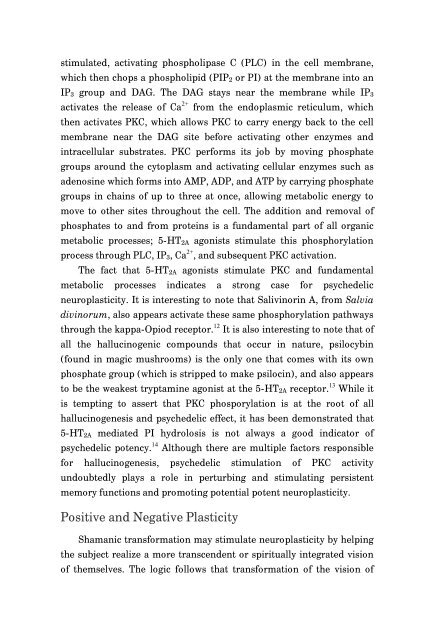Psychedelic-information-theory-Shamanism-in-the-age-of-Reason
Psychedelic-information-theory-Shamanism-in-the-age-of-Reason
Psychedelic-information-theory-Shamanism-in-the-age-of-Reason
- No tags were found...
Create successful ePaper yourself
Turn your PDF publications into a flip-book with our unique Google optimized e-Paper software.
stimulated, activat<strong>in</strong>g phospholipase C (PLC) <strong>in</strong> <strong>the</strong> cell membrane,which <strong>the</strong>n chops a phospholipid (PIP 2 or PI) at <strong>the</strong> membrane <strong>in</strong>to anIP 3 group and DAG. The DAG stays near <strong>the</strong> membrane while IP 3activates <strong>the</strong> release <strong>of</strong> Ca 2+ from <strong>the</strong> endoplasmic reticulum, which<strong>the</strong>n activates PKC, which allows PKC to carry energy back to <strong>the</strong> cellmembrane near <strong>the</strong> DAG site before activat<strong>in</strong>g o<strong>the</strong>r enzymes and<strong>in</strong>tracellular substrates. PKC performs its job by mov<strong>in</strong>g phosphategroups around <strong>the</strong> cytoplasm and activat<strong>in</strong>g cellular enzymes such asadenos<strong>in</strong>e which forms <strong>in</strong>to AMP, ADP, and ATP by carry<strong>in</strong>g phosphategroups <strong>in</strong> cha<strong>in</strong>s <strong>of</strong> up to three at once, allow<strong>in</strong>g metabolic energy tomove to o<strong>the</strong>r sites throughout <strong>the</strong> cell. The addition and removal <strong>of</strong>phosphates to and from prote<strong>in</strong>s is a fundamental part <strong>of</strong> all organicmetabolic processes; 5-HT 2A agonists stimulate this phosphorylationprocess through PLC, IP 3, Ca 2+ , and subsequent PKC activation.The fact that 5-HT 2A agonists stimulate PKC and fundamentalmetabolic processes <strong>in</strong>dicates a strong case for psychedelicneuroplasticity. It is <strong>in</strong>terest<strong>in</strong>g to note that Saliv<strong>in</strong>or<strong>in</strong> A, from Salviadiv<strong>in</strong>orum, also appears activate <strong>the</strong>se same phosphorylation pathwaysthrough <strong>the</strong> kappa-Opiod receptor. 12 It is also <strong>in</strong>terest<strong>in</strong>g to note that <strong>of</strong>all <strong>the</strong> halluc<strong>in</strong>ogenic compounds that occur <strong>in</strong> nature, psilocyb<strong>in</strong>(found <strong>in</strong> magic mushrooms) is <strong>the</strong> only one that comes with its ownphosphate group (which is stripped to make psiloc<strong>in</strong>), and also appearsto be <strong>the</strong> weakest tryptam<strong>in</strong>e agonist at <strong>the</strong> 5-HT 2A receptor. 13 While itis tempt<strong>in</strong>g to assert that PKC phosporylation is at <strong>the</strong> root <strong>of</strong> allhalluc<strong>in</strong>ogenesis and psychedelic effect, it has been demonstrated that5-HT 2A mediated PI hydrolosis is not always a good <strong>in</strong>dicator <strong>of</strong>psychedelic potency. 14 Although <strong>the</strong>re are multiple factors responsiblefor halluc<strong>in</strong>ogenesis, psychedelic stimulation <strong>of</strong> PKC activityundoubtedly plays a role <strong>in</strong> perturb<strong>in</strong>g and stimulat<strong>in</strong>g persistentmemory functions and promot<strong>in</strong>g potential potent neuroplasticity.Positive and Negative PlasticityShamanic transformation may stimulate neuroplasticity by help<strong>in</strong>g<strong>the</strong> subject realize a more transcendent or spiritually <strong>in</strong>tegrated vision<strong>of</strong> <strong>the</strong>mselves. The logic follows that transformation <strong>of</strong> <strong>the</strong> vision <strong>of</strong>


